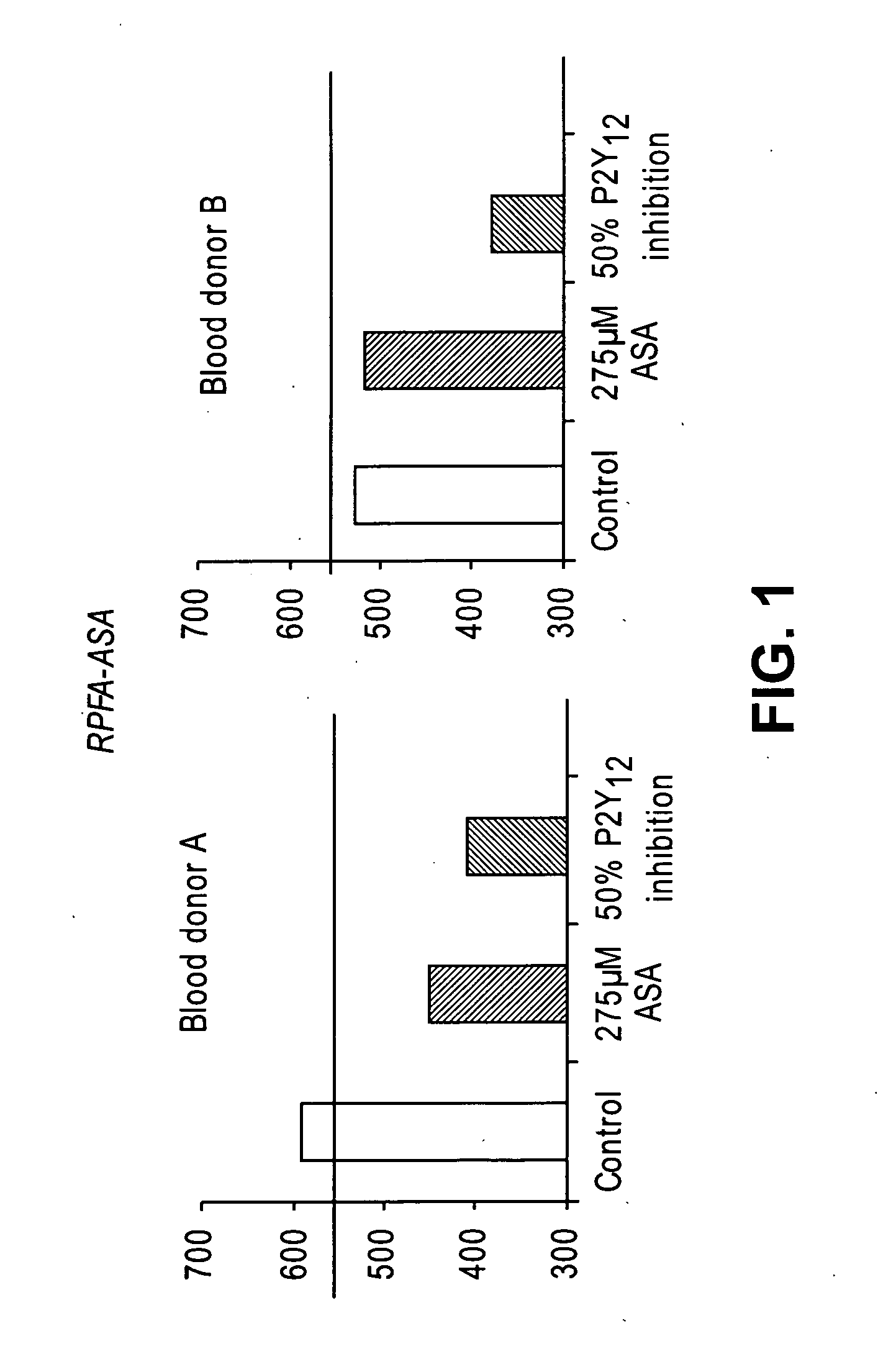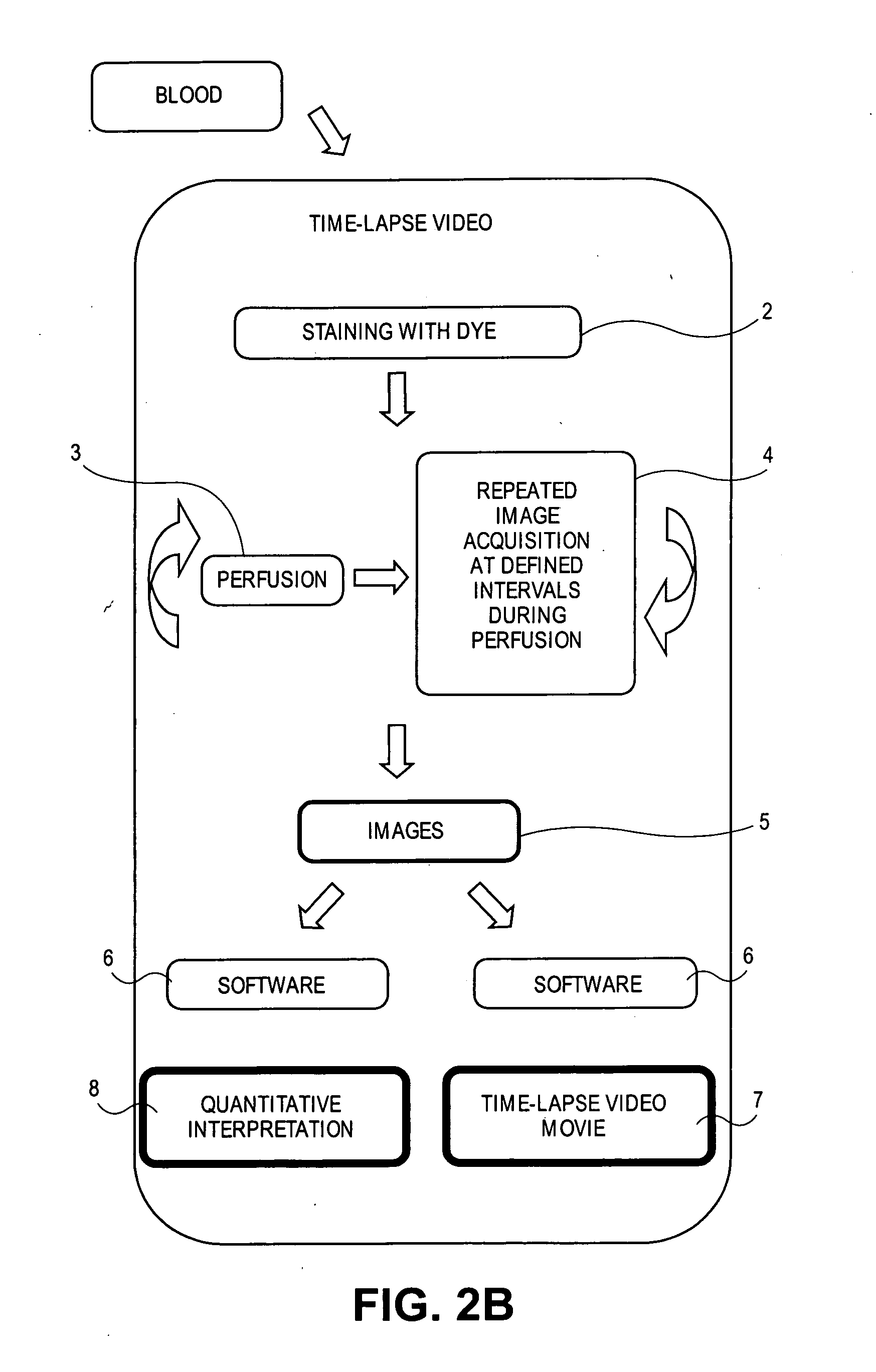Device and methods for identifying and treating aspirin non-responsive patients
- Summary
- Abstract
- Description
- Claims
- Application Information
AI Technical Summary
Benefits of technology
Problems solved by technology
Method used
Image
Examples
example 1
Evaluation of RPFA-ASA and PFA-100
[0139] The effects of aspirin (275 μM added to the blood in vitro) and 50% inhibition of P2Y12 (corresponding to the extent of inhibition achieved in patients under Plavix treatment) were evaluated in the RPFA-ASA (n=5). A direct P2Y12 antagonist (5-chloro-N-[({4-[7-fluoro-6-(methylamino)-1-oxoisoquinolin-2(1H)-yl]phenyl}amino)carbonyl]thiophene-2-sulfonamide) is used in vitro at a concentration that inhibits 50% of ADP-induced platelet aggregation in PRP as Plavix cannot be used in vitro (it needs to be metabolized by the liver to generate the active metabolite). The results show that aspirin effects were smaller than that obtained with 50% inhibition of P2Y12 (FIG. 1, blood donor A and B) for all 5 blood donors. Also, one donor presented an aspirin-like phenotype without addition of aspirin or aspirin uptake (donor B). Since the actual anti-platelet regimen consists of a combination of aspirin and P2Y12 antagonist, the RPFA-ASA assay cannot dete...
example 2
Perfusion Chamber Assays
[0142] In one example of the perfusion chamber assay of the invention, the assay enables the investigator to evaluate thrombotic process under arterial shear rates in less than 15 minutes after blood draw. The simplicity of the perfusion chamber allows for multiple parallel experiments as the thrombogenic surface is deposited inside a regular glass capillary tube. The system is easy to use as only 2 tubings are needed: a proximal tubing to connect the blood sample to the capillary, and a distal tubing which connects the capillary to the pump. A limited amount of blood is required to reconstitute arterial shear rate conditions (4 ml of blood for 1 perfusion chamber). Whole blood (non-anticoagulated, PPACK-, or citrate-anticoagulated human blood) is perfused through fibrillar type III collagen-coated capillaries at arterial shear rates for 4 minutes.
[0143] At the end of the perfusion, the capillary is rinsed for 20 sec and fixed with 2.5% phosphate buffered ...
example 3
Collagen-Coated Perfusion Chamber Assay to Measure Aspirin Resistance in Whole Blood.
[0145] Platelets are labeled in whole blood with Rhodamine 6G and used to show that aspirin and thrombin inhibitors synergize with P2Y12 antagonism (Andre, P. et al., Circulation, 108(21):2697-703 (2003)). After blood collection into either citrate or PPACK (4 ml are needed per perfusion chamber) Rhodamine 6G (0.2 mg / mL) is added to the blood and incubated at 37° C. for 5 minutes. Collagen-coated rectangular glass capillaries (Vitrocom) are mounted on the stage of a fluorescent microscope and illuminated under light, UV, or both. Whole blood is perfused at 1000 / sec through the capillaries. Platelet collagen interactions and thrombus formation are recorded in real time with the Simple PCI software. The mean fluorescence intensity parallels the kinetics of the thrombotic process, because all platelets are labeled by rhodamine 6G. The kinetics of the thrombotic process is recorded at 2 frames per sec...
PUM
 Login to View More
Login to View More Abstract
Description
Claims
Application Information
 Login to View More
Login to View More - R&D
- Intellectual Property
- Life Sciences
- Materials
- Tech Scout
- Unparalleled Data Quality
- Higher Quality Content
- 60% Fewer Hallucinations
Browse by: Latest US Patents, China's latest patents, Technical Efficacy Thesaurus, Application Domain, Technology Topic, Popular Technical Reports.
© 2025 PatSnap. All rights reserved.Legal|Privacy policy|Modern Slavery Act Transparency Statement|Sitemap|About US| Contact US: help@patsnap.com



